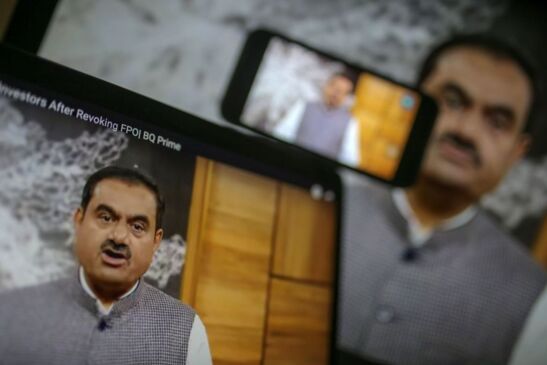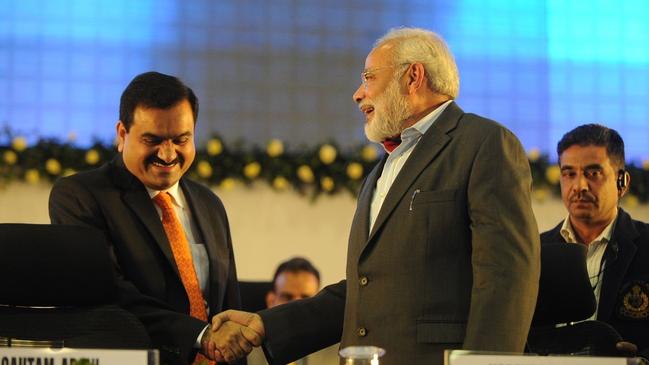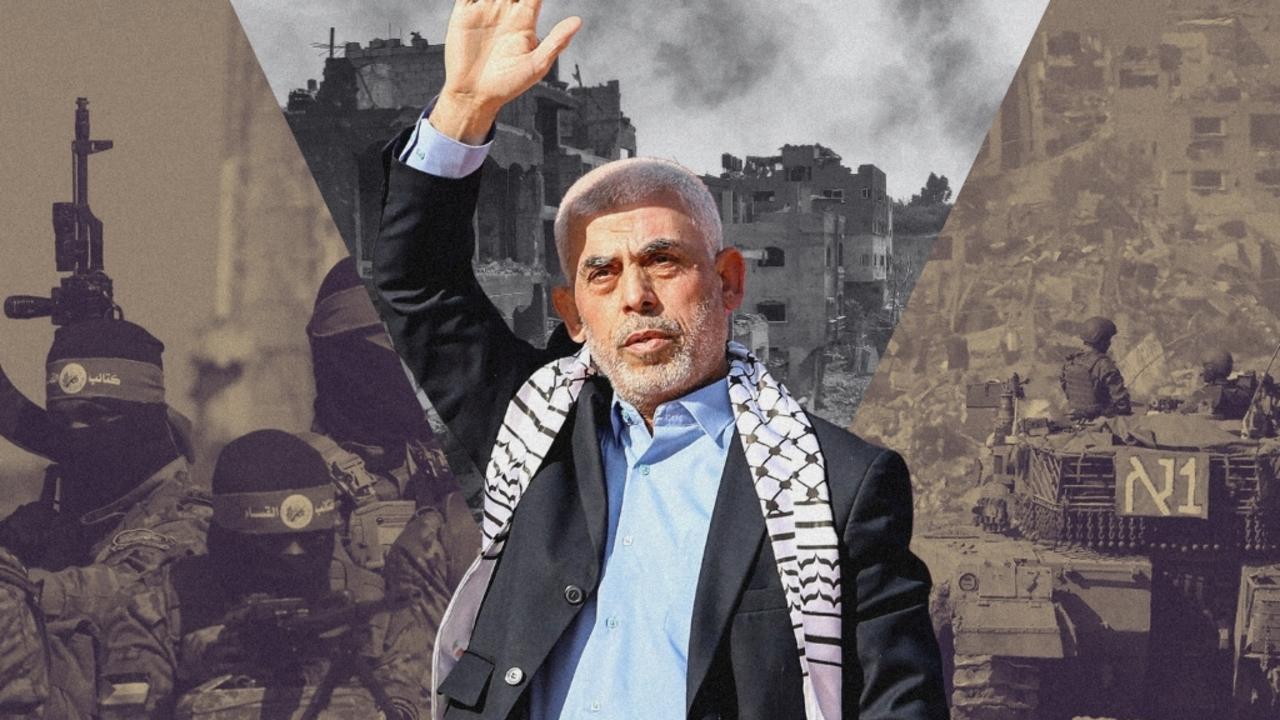The rise and hard fall of industrial baron Gautam Adani’s empire
Gautam Adani’s name is plastered on billboards, airports and shipping docks across India. Now he’s in a bitter fight he casts as an attack on the nation itself.

Gautam Adani is ubiquitous in India. His name is plastered on roadside billboards and on the airports and shipping docks he operates. His power plants light Mumbai office towers and irrigate rural fields, fuelled by coal he imports from mines as far away as Australia. He recently expanded into defence and media.
So when US short seller Hindenburg Research alleged last week that the Adani Group – the energy and infrastructure conglomerate he controls – was engaged in wide-ranging fraud, the fallout was widespread and severe. His companies’ stocks and bonds plunged, leaving investors with billions of dollars in losses and igniting a bitter fight that the company cast as an assault on the nation itself. On Wednesday, Mr Adani’s flagship company, Adani Enterprises, cancelled a stock sale of up to $US2.5bn ($3.5bn).
The Adani Group denied the short seller’s allegations, describing the report as “a calculated attack on India, the independence, integrity and quality of Indian institutions, and the growth story and ambition of India”. Hindenburg shot back that Adani’s rebuttal stoked nationalist sentiment without adequately addressing the issues the firm had raised.
India’s rise as a global economic heavyweight has long buoyed Mr Adani’s fortunes. As tens of millions of Indians joined the middle class over the past decade, Adani companies worked hand-in-glove with the government of Prime Minister Narendra Modi to modernise the country’s infrastructure, from airports to shipping docks, while importing enough fuel to keep the country’s economy of 1.4 billion people on an upward trajectory.
Now, Mr Adani’s symbiosis with the Indian economy is being tested. The 104-page report released by Hindenburg Research alleged that Adani Group had engaged in fraud, including stockmarket manipulation by using a network of overseas shell companies and questionable accounting and business practices. The Adani Group’s 413-page rebuttal called the short seller’s report “nothing but a lie”.

Mr Adani’s fortune is taking a hit. In September 2022, Mr Adani, 60, briefly displaced Amazon founder Jeff Bezos as the world’s second-richest man, with a net worth of $US147bn, according to the Bloomberg Billionaires Index.
As of Wednesday, the seven listed companies bearing Mr Adani’s name had lost about $US85bn in market capitalisation since the release of the report. They are now worth $US132.3bn, according to FactSet data. Mr Adani slid to 10th in the Bloomberg index, with a net worth of $US84.5bn.
Mr Adani made no mention of the Hindenburg report on Tuesday when he spoke publicly for the first time since its publication. At a ceremony marking the Adani Group’s acquisition of the Port of Haifa in Israel, he cited the conglomerate’s strong ties to the Israeli economy.
Gujarat model shaken
Hindenburg’s allegations have shaken what many Indians call the Gujarat model of economic growth – a reference to the home state of both Mr Adani and Mr Modi. The approach has involved using large government subsidies to fund infrastructure construction by private firms.
The opposition Congress party has used the Hindenburg report to cast the Adani Group as an oligarch enabled by the Modi government.
“It says a lot about what corporate India is like,” said Hemindra Hazari, a Mumbai-based analyst who specialises in the Indian capital markets. Investors, he said, were “clearly very shaken up”.

A spokesman for the Modi government didn’t respond to requests for comment. The Adani Group referred a reporter to Mr Adani’s past TV interviews, in which he was asked about his relationship with Mr Modi.
“Most of the people like Mr Modi, and they don’t find any problems in Adani’s development model,” Mr Adani said in a January 7 interview on India TV. He said some of the biggest breaks of his career came when the current opposition was in power.
India’s gross domestic product has risen from $US1.82 trillion in 2011 to $US3.18 trillion in 2021, according to World Bank data, making it one of the fastest-growing economies in the world. It is on track to become the world’s third-largest economy by 2027, and to have the third-largest stockmarket by 2030, according to Morgan Stanley, which says India’s GDP could more than double to $US7.5 trillion by 2031.
Mr Adani is involved in the Modi government’s plans to pivot the economy from fossil fuels to cleaner sources of energy such as wind and solar power. He has vowed to build three factories to make solar modules, wind turbines and hydrogen electrolysers, part of his plan to invest $US70bn in cleaner technologies over the next decade. He is developing a vast solar farm in India’s northwestern desert.
Mr Adani’s empire began in Gujarat, a state on India’s northwest coast, bordering Pakistan. The youngest of five children, he grew up in the city of Ahmedabad, where his family was active in commodity trading.
He dropped out of school as a teenager and moved to Mumbai to work in the city’s diamond markets. He has said that abandoning his studies was unfortunate, but that the diamond trade taught him how to cut a deal. “Education makes a person knowledgeable,” he said in the India TV interview. “I chose another path: hard work and experience.”
Mr Adani returned to Ahmedabad in the early 1980s to work with his older brother, Mahasukh, who had acquired a plastics maker. He worked there as an importer, procuring raw materials for the firm’s factories. The family later founded Adani Exports, sending goods such as toothpaste and shoe polish to global markets.

In the early 1990s, India fell into an economic crisis fuelled in part by the economy’s reliance on imports. The government secured an emergency loan from the International Monetary Fund and embarked on a privatisation drive.
Adani Exports began buying land at Mundra Port, which was owned by the state of Gujarat. Mundra’s deep waters made it ideal for docking massive ships, and its position along the Arabian Sea made it an effective gateway for Asian goods to travel west.
Mr Adani said in the TV interview he paid one rupee a square foot, the equivalent of just over 1c, for land that was costly to develop because it was underwater at high tide. “The cost of the reclamation is far bigger than the cost of the land,” he said.
He later proposed forming a joint venture with the state of Gujarat, which still owned land in the area, to further develop the port. Gujarat’s government approved the venture.
In 2001, after climbing the ranks of the Hindu nationalist Bharatiya Janata Party, Mr Modi was appointed chief minister of Gujarat’s government. He helped its economy grow by providing incentives to attract businesses such as auto manufacturers, upgrading the electricity supply and improving irrigation for farmers.
Under Mr Modi, the Gujarat government sold the state’s stake in the port joint venture to Adani Exports for two billion rupees, about $US34m at today’s exchange rate, according to a 2014 report by the federal government auditor.
“The development of Mundra Port, which was envisaged as a joint sector port, turned out to be a private sector port for which competitive bidding was not followed,” the report said.
Mr Adani built a rail line to the port, making it the first in India connected to the national rail system. That allowed him to turbocharge the movement of goods through Mundra. The central government designated the port a special economic zone, providing another incentive to do business there.
India lacked abundant supplies of fossil fuels, so Mr Adani began importing coal from Indonesia and Australia. He built a giant conveyor belt in Mundra to carry coal from the dock to a nearby Adani power plant. Electricity generated at the plant moved over Adani transmission lines to surrounding cities and towns.
“I proudly say that we had a very good experience with the Modi government,” Mr Adani said in the interview, referring to Mr Modi’s Gujarat administration.
Modi’s rise to power
Mundra became India’s largest private port, which allowed Mr Modi to brandish his pro-business credentials as he prepared to run for prime minister. A Hindu nationalist, Mr Modi tapped into the frustrations of a generation of Indians who had climbed out of poverty but didn’t reach the middle class because of slowing growth and a lack of employment.

After Mr Modi won, his government sought to further accelerate growth. That included a plan to privatise the operation of six airports. Companies in the bidding weren’t required to have any experience in building or operating airports. Mr Adani won all six contracts, making his company India’s largest airport operator.
As Mr Adani’s businesses grew, he spun them off into separately listed companies, including Adani Ports and Special Economic Zone, Adani Total Gas and Adani Transmission. Adani Exports changed its name to Adani Enterprises, which the company now considers an incubator of new business lines. In November, company executives said Adani Airports and Adani Roads were in its “incubation pipeline”.
Adani Group’s expansion into new businesses such as data centres, copper refining and hydrogen drew it into capital-intensive sectors, where analysts say its companies have limited experience. Much of that expansion was funded by debt. Analysts have said many projects aren’t expected to turn a profit for a few years.
Debt-research firm CreditSights published a report in August describing Adani Group as “deeply overleveraged”. Adani Green Energy had a debt-to-equity ratio of 2023 per cent at the end of the fiscal year ended March 31, 2022, the report said, while Adani Transmission’s was 272 per cent.
The report warned that if one of the conglomerate’s companies became financially distressed, it could hit the valuations of others.
Adani Group said in September the debt ratios of its companies continued “to be healthy and are in line with industry benchmarks”, and that the companies had consistently reduced their debt loads.
In November, Adani Enterprises announced plans for a stock sale aiming to raise as much as $US2.5bn. It said some of the funds would be used to repay debt and fund capital expenditures for green energy projects, expressway construction and airport works.
Three days before the public offering began last Friday, the Hindenburg report was released, sending shares of Adani companies plummeting.
In the report, the New York-based short seller alleged that Adani has manipulated the price of its shares by using a network of offshore shell companies to purchase shares across its companies. It said Adani Group stocks were overvalued and its debt too high.
In its rebuttal, Adani said the report was full of unsubstantiated allegations that created a misleading narrative. Over the past five years, it said, the conglomerate had lowered its ratio of net debt to earnings before interest, taxes, depreciation and amortisation.
On Tuesday, Adani Enterprises had lined up enough investor bids to complete the stock offering, including those from state-owned entities Life Insurance Corp of India and SBI Life Insurance.
Late on Wednesday, the day the company was meant to price the deal, it cancelled the share sale.
Additional reporting: Krishna Pokharel, Weilun Soon


